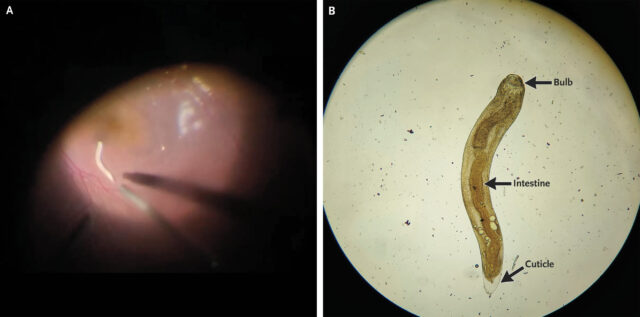For eight months, a 35-year-old man in India was bothered by his left eye. It was red and blurry. When he finally visited an ophthalmology clinic, it didn’t take long for doctors to unearth the cause.
In a case report in the New England Journal of Medicine, doctors report that they first noted that the eye was bloodshot and inflamed, and the pupil was dilated and fixed. The man’s vision in the eye was 20/80. A quick look inside his eye revealed it was all due to a small worm, which they watched “moving sluggishly” in the back of his eyeball.
To gouge out the parasitic pillager, the doctors performed a pars plana vitrectomy—a procedure that involves sucking out some of the jelly-like vitreous inside the eye. This procedure can be used in the treatment of a variety of eye conditions, but using it to hoover up worms is rare. In order to get in, the doctors make tiny incisions in the white parts of the eye (the sclera) and use a hollow needle-like device with suction. They replace extracted eye jelly with things like saline.
In this case, the device was able to suck in part of the worm’s tail and drag it out—still squirming. Under the microscope, they quickly identified the peeper creeper. With a bulbous head, well-formed intestines, and a thick outer layer, it perfectly fit the description of Gnathostoma spinigerum, a known bodily marauder that can sometimes wiggle its way into eyeballs.

Stomach-churning cycle
G. spinigerum are endemic parasites in India that infect carnivorous mammals, particularly wild and domestic cats and dogs. In these primary hosts, adult worms form tumor-like masses on the walls of the animals’ intestinal tracts. There, the adults mate, and the mass erupts like an infernal, infectious volcano, spewing out eggs. The eggs are passed in the animals’ feces and can then spread to intermediate hosts. These include freshwater plankton, which get eaten by fish and amphibians, which then get eaten by the cats and dogs to complete the cycle. The young parasites can also be taken up by dead-end hosts like birds, including chickens, and snakes—these are called paratenic hosts.
Source link
